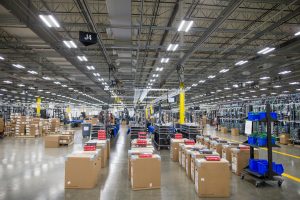Have questions about building a CCTV system?
Contact Us.
Employers all over Alberta take precautions to keep their staff, customers and facilities safe. They install access control devices like keypads to manage access to restricted areas. Business owners hire security guards and equip them with two-way radios so they can communicate and coordinate their efforts. Passwords are used to protect computers, and, in many cases, video surveillance is used to provide a watchful eye and deter criminal activity.
Walk into a gas station or retail outlet, and you’ll see CCTV cameras installed. But you’d expect that. The thing is, video surveillance systems provide security across industries and sectors. Edmonton’s public transit system has cameras installed at all LRT stations, on buses, and in trains to protect passengers and drivers. Dispatchers at the University of Calgary use video surveillance to alert guards to incidents. Drive up to any bitumen mine in the Fort McMurray Oil Sands, and you’ll see cameras at the gate so site security can determine who’s coming and going.
Business owners often have several questions before implementing a video surveillance system, and understandably so. Here are the most common questions our Client Support Specialists have come across so far.
Do I Really Need it?
It depends on your business, your budget, and your security requirements.
Let’s say, for example, you work in a relatively small office that doesn’t keep cash on the premises. If you don’t have much in the way of expensive equipment or sensitive information on site, then video surveillance might be over and above what your security needs are.
But, if your business does have expensive equipment or sensitive information on site, then you may want to consider a more robust security solution. And if there is cash on the premises, like at a liquor store or casino, or if there is the potential for theft or violence, then having a surveillance system in place could go a long way towards providing security for your business, customers, and staff.
This becomes even more necessary as you move from small facilities, like convenience stores, to larger facilities like warehouses or manufacturing plants. Surveillance systems are essential tools in these sprawling environments. They monitor activity and collect evidence, so your security staff doesn’t have to be everywhere at all times.
What Kind of Equipment Do I Need?
The answer to that question will depend on how complex your security requirements are. Generally, there are three major components you’ll have to install.
Surveillance Cameras
The most obvious components are the cameras themselves. As you might expect, you have a range of options, so it’s best to think about the kind of coverage you need, and where you need it. For example, if you were trying to secure a 24-hour parking structure in downtown Edmonton, you’ll probably want something that can stand up to cold temperatures and low light conditions. On the other hand, if you’re trying to secure warehouse inventory after hours, cameras with a 360-degree rotation might be a higher priority, as they would help you cover a wide area.
There are plenty of other factors to consider, so it’s important to consult with your solutions provider. Work together to map out a clear plan before buying and installing anything.
Hooking Up Your Cameras – Structured Cabling or Wireless
This refers to how your cameras will be linked to monitoring stations and data storage devices. In short, structured cabling refers to the data cables that will run from your CCTV cameras to your server or DVR (Digital Video Recorder) as well as the monitoring station in your security office. This kind of cabling also keeps information flowing around your office, from computer or printer to server and back.
Because these data cables will run throughout your facility, planning is key. You want your structured cabling layout to be easy to manage, modify, repair and maintain. This level of infrastructure also means this kind of installation will be more permanent.
If you’re looking for short term video surveillance (say, for a construction site), or something simple for a small office, you may want to go with a wireless surveillance solution. While you may sacrifice bandwidth, you’ll gain a lot through ease of installation and mobility.
The Network Video Recorder
The network video recorder (NVR) is connected to the same IP network as your surveillance system. It allows your security team to monitor and record CCCTV feeds, to take freeze-frame images, and to transmit feed anywhere, be it to a remote monitoring station or a mobile device. This component is as essential as it is valuable.
Can I install It on my own?
It really depends on the skill set you have on hand and how complicated your surveillance system is going to be.
A simple setup, like wireless camera streaming to a desktop computer, may be simple enough to handle on your own. But, if you go with a wired solution, or if you plan on using multiple cameras throughout your building, having trained technicians plan and install your system will save you a lot of pain and frustration down the road.
Will CCTV Work in Low Light Conditions?
The short answer is ‘Yes’. But you need to have the right type of camera installed.
Manufacturers like Avigilon have produced cameras that use thermal imaging to capture reliable and usable footage in low light conditions. Thermal imaging technology works by enabling CCTV cameras to ‘see’ the heat radiated by people, animals, vehicles, and anything else that generates heat – which is everything. Because they can see heat, thermal CCTV cameras can operate in low light conditions, or even total darkness.
Of course, ‘seeing’ heat is a lot different than seeing a physical object. Because of this, thermal imaging CCTV cameras relay information differently. They convert the footage they capture into shapes and send that information back to the monitoring stations so it can be easily viewed and understood. The shapes are displayed in various shades of grey or in different colors, depending on the level of heat that the object is giving off. This information can be useful to security staff.
For example, should a guard see a car parked in a parking lot after hours, a relatively cool heat signature would inform him that the car had been parked for a period of time. A warmer heat signature, however, would tell the guard that the vehicle had recently been running, and had likely just arrived on site. Different responses, if necessary, could be organized based on the information.
The video below is from Avigilon, a leading security provider specializing in video surveillance and access control. Watch to see thermal CCTV in action.
Are There Legal Factors to Consider When Using CCTV In the Workplace?
Absolutely.
In Alberta, the Office of the Information and Privacy Commissioner has set out guidelines for when, and why CCTV cameras can be used. This is an effort to balance the security needs of a business with the privacy rights of customers and staff.
Chief among these guidelines is that there is no less invasive alternative that would meet the security requirements of the business. Following that is the requirement that there be a clearly defined business need. Equally important to these is the requirement that CCTV cameras not be placed in or aimed at any place employees would have a reasonably heightened expectation of privacy. Similarly, for privacy reasons, audio may not be recorded unless there is a clear and specific need to do so.
For more info on the guideline around using CCTV in the workplace, click here.
How Much Will It Cost?
That will depend on the complexity and scope of the system you need. Your best bet is to work closely with your provider. Let them know what your business goals are for your surveillance systems, and if you have questions, ask them. That way, a solution can be built that fits your budget and meets your needs.
Getting Started
CCTV systems can be highly effective tools for securing your operation and providing an added degree of safety for staff and customers alike. With the right equipment and training, your security team can keep a constant eye on your facility and respond to any threats or emergencies that arise.
If you’d like to get to work building a surveillance system, or if you want a review of your current CCTV setup, Contact Us. Our team is here to help.
Tridon is a full solution Telecom Systems Integrator with CSA certification and licensed by APEGA. Our Engineering, Service and Tower Divisions collaborate with customers to build engineered solutions including communications systems design, tower inspections and co-location, wireless broadband, fiber optic cabling, site security, and two-way radio communication.





